设计模式七大原则
设计模式的目的:编写软件过程中,程序员面临着来自耦合性,内聚性以及可维护性,可扩展性,重用性,灵活性等多方面的挑战,设计模式是为了让程序(软件),具有更好的:
1、代码重用性:相同功能的代码,不用多次编写;
2、可读性:编程规范性,便于其他程序员的阅读和理解
3、可扩展性:当需要增加新的功能时,非常的方便,称为可维护;
4、可靠性:当我们增加新的功能后,对原来的功能没有影响;
5、使程序呈现高内聚,低耦合的特性。
下面我们来具体看一下,设计模式七大原则。
单一职责原则
对类来说的,即一个类应该只负责一项职责。如类A负责两个不同职责:职责1,职责2。当职责1需求变更而改变A时,可能造成职责2执行错误,所以需要将类A的粒度分解为A1,A2。
下面我们看一下具体的案例.
public class Demo {
public static void main(String[] args) {
Vehicle vehicle = new Vehicle();
vehicle.run("摩托车");
vehicle.run("汽车");
vehicle.run("飞机");
}
}
// 交通工具类
// 问题:在run方法中,违反了单一职责原则
// 解决:根据交通工具的运行方法不同,分解成不同类即可
class Vehicle{
public void run(String vehicleName){
System.out.println(vehicleName + " 在公路上运行......");
}
}
// 摩托车 在公路上运行......
// 汽车 在公路上运行......
// 飞机 在公路上运行......
我们不难发现,交通工具类的run方法不仅要管公路上跑的交通工具,还要管天上飞的交通工具。因此,我们需要对交通工具类的职责根据运行方式的不同进行拆分。
// 针对类进行修改
public class improved {
public static void main(String[] args) {
RoadVehicle roadVehicle = new RoadVehicle();
roadVehicle.run("摩托车");
AirVehicle airVehicle = new AirVehicle();
roadVehicle.run("飞机");
}
}
// 改进后的方式,遵守单一职责原则
// 问题:改动很大,既对类进行拆解,同时还修改客户端
class RoadVehicle{
public void run(String vehicleName){
System.out.println(vehicleName + " 在公路上运行......");
}
}
class AirVehicle{
public void run(String vehicleName){
System.out.println(vehicleName + " 在天空运行......");
}
}
class WaterVehicle{
public void run(String vehicleName){
System.out.println(vehicleName + " 在水中运行......");
}
}
针对方案二的解决方案是直接修改Vehicle类,这样改动的代码相对来说较少。
// 针对方法进行修改
public class FinalMethod {
public static void main(String[] args) {
VehicleImproved vehicle = new VehicleImproved();
vehicle.runRoad("摩托车");
vehicle.runAir("飞机");
vehicle.runWater("船");
}
}
class VehicleImproved{
public void runRoad(String vehicleName){
System.out.println(vehicleName + " 在公路上运行......");
}
public void runAir(String vehicleName){
System.out.println(vehicleName + " 在天上运行......");
}
public void runWater(String vehicleName){
System.out.println(vehicleName + " 在水中运行......");
}
}
单一职责原则注意事项和细节:
1、降低类的复杂度,一个类只负责一项职责;
2、提高类的可读性,可维护性;
3、降低变更引起的风险;
4、通常情况下,我们应当遵守单一职责原则,只有逻辑足够简单,才可以在代码级违反单一职责原则;
5、只有类中方法数量足够少,可以在方法级别保持单一职责原则。
在我们上面交通工具案例中,仅有一个方法,所以我们在方法级别上改进,使得遵守单一职责原则。若是还有很多其他的方法和交通工具的种类相关,这时候我们就需要使用方案二在类的级别上遵守单一职责原则。
接口隔离原则
客户端不应该依赖它不需要的接口,即一个类对另一个类的依赖应该建立在最小的接口上。
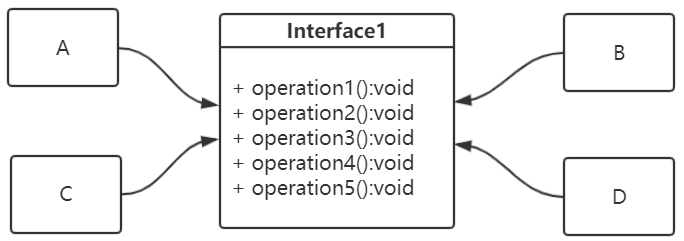
如上图所示,
1、类A通过接口Interface1依赖类B,但是只会用到接口中的1,2,3三个方法;
2、类C通过接口Interface1依赖类D,但是只会用到接口中的1,4,5三个方法;
也就是说,如果接口Interface1对于类A和类C来说不是最小接口,那么类B和类D必须去实现他们不需要的方法。
//接口
interface Interface1 {
void operation1();
void operation2();
void operation3();
void operation4();
void operation5();
}
class B implements Interface1 {
public void operation1() {
System.out.println("B 实现了 operation1");
}
public void operation2() {
System.out.println("B 实现了 operation2");
}
public void operation3() {
System.out.println("B 实现了 operation3");
}
public void operation4() {
System.out.println("B 实现了 operation4");
}
public void operation5() {
System.out.println("B 实现了 operation5");
}
}
class D implements Interface1 {
public void operation1() {
System.out.println("D 实现了 operation1");
}
public void operation2() {
System.out.println("D 实现了 operation2");
}
public void operation3() {
System.out.println("D 实现了 operation3");
}
public void operation4() {
System.out.println("D 实现了 operation4");
}
public void operation5() {
System.out.println("D 实现了 operation5");
}
}
//A 类通过接口Interface1 依赖(使用) B类,但是只会用到1,2,3方法
class A {
public void depend1(Interface1 i) {
i.operation1();
}
public void depend2(Interface1 i) {
i.operation2();
}
public void depend3(Interface1 i) {
i.operation3();
}
}
//C 类通过接口Interface1 依赖(使用) D类,但是只会用到1,4,5方法
class C {
public void depend1(Interface1 i) {
i.operation1();
}
public void depend4(Interface1 i) {
i.operation4();
}
public void depend5(Interface1 i) {
i.operation5();
}
}
那么,按隔离原则应当这样处理:将接口Interface1拆分为独立的几个接口,类A和类C分别与他们需要的接口建立依赖关系。也就是采用接口隔离原则。
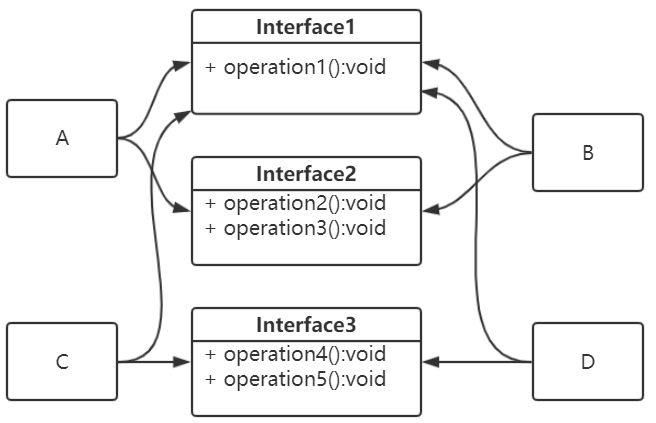
public class Segregation {
public static void main(String[] args) {
A a = new A();
a.depend1(new B()); // A类通过接口去依赖B类
a.depend2(new B());
a.depend3(new B());
C c = new C();
c.depend1(new D()); // C类通过接口去依赖(使用)D类
c.depend4(new D());
c.depend5(new D());
}
}
// 接口1
interface Interface1 {
void operation1();
}
// 接口2
interface Interface2 {
void operation2();
void operation3();
}
// 接口3
interface Interface3 {
void operation4();
void operation5();
}
class B implements Interface1, Interface2 {
public void operation1() {
System.out.println("B 实现了 operation1");
}
public void operation2() {
System.out.println("B 实现了 operation2");
}
public void operation3() {
System.out.println("B 实现了 operation3");
}
}
class D implements Interface1, Interface3 {
public void operation1() {
System.out.println("D 实现了 operation1");
}
public void operation4() {
System.out.println("D 实现了 operation4");
}
public void operation5() {
System.out.println("D 实现了 operation5");
}
}
// A 类通过接口Interface1,Interface2 依赖(使用) B类,但是只会用到1,2,3方法
class A {
public void depend1(Interface1 i) {
i.operation1();
}
public void depend2(Interface2 i) {
i.operation2();
}
public void depend3(Interface2 i) {
i.operation3();
}
}
// C 类通过接口Interface1,Interface3 依赖(使用) D类,但是只会用到1,4,5方法
class C {
public void depend1(Interface1 i) {
i.operation1();
}
public void depend4(Interface3 i) {
i.operation4();
}
public void depend5(Interface3 i) {
i.operation5();
}
}
依赖倒置原则
基本介绍
1、高层模块不应该依赖低层模块,二者都应该依赖其抽象;
2、抽象不应该依赖细节,细节应该依赖抽象;
3、依赖倒转(倒置)的中心思想是面向接口编程;
4、依赖倒转原则是基于这样的设计理念:相对于细节的多变性,抽象的东西要稳定的多。以抽象为基础搭建的架构比以细节为基础的架构要稳定的多。在java中,抽象指的是接口或抽象类,细节就是具体的实现类;
5、使用接口或抽象类的目的是制定好规范,而不涉及任何具体的操作,把展现细节的任务交给他们的实现类去完成。
下面让我们来看一下具体的案例。
public class OriginalVersion {
public static void main(String[] args) {
Person person = new Person();
person.receive(new Email());
}
}
class Email{
public String getInfo(){
return "电子邮件信息:hello, world";
}
}
// 1、实现简单
// 2、若是获取的是微信,QQ等消息,要增加类,同时Person也要增加相应的接受方法
// 3、解决:引入抽象的接口IReceiver,表示接受则会,这样Person类与接口IReceiver发生依赖
class Person{
public void receive(Email email){
System.out.println(email.getInfo());
}
}
下面我们根据依赖倒置原则实现Person接受消息的功能。
public class Improved {
public static void main(String[] args) {
// 客户端不需要改变
Person person = new Person();
person.receive(new Wechat());
person.receive(new Email());
}
}
interface IReciever{
String getInfo();
}
class Email implements IReciever{
@Override
public String getInfo() {
return "电子邮件消息......";
}
}
class Wechat implements IReciever{
@Override
public String getInfo() {
return "微信消息......";
}
}
class Person{
public void receive(IReciever reciever){
System.out.println(reciever.getInfo());
}
}
里氏替换原则
面向对象编程中的关于继承性的思考和说明:
1、继承包含这样一层含义:父类中凡是已经实现好的方法,实际上是在设定规范和契约,虽然它不强制要求所有的子类必须遵循这些契约,但是如果子类对这些已经实现的方法任意修改,就会对整个继承体系造成破坏。
2、继承在给程序设计带来便利的同时,也带来了弊端。比如使用继承会给程序带来侵入性,程序的可移植性降低,增加对象间的耦合性,如果一个类被其他的类所继承,则当这个类需要修改时,必须考虑到所有的子类,并且父类修改后,所有涉及到子类的功能都有可能产生故障;
3、问题提出:在编程中,如何正确的使用继承? =>里氏替换原则
里氏替换原则基本介绍:
1、如果对每个类型为T1的对象o1,都有类型为T2的对象o2,使得以T1定义的所有程序P在所有的对象o1都代换成o2时,程序P的行为没有发生变化,那么类型T2是类型T1的子类型。换句话说,所有引用基类的地方必须能透明地使用其子类的对象;
2、在使用继承时,遵循里氏替换原则,在子类中尽量不要重写父类方法;
3、里氏替换原则告诉我们,继承实际上让两个类耦合性增强了,在适当的情况下,可以通过聚合,组合,依赖来解决问题。
public class liskov {
public static void main(String[] args) {
A a = new A();
System.out.println("11-3=" + a.func1(11, 3));
System.out.println("1-8=" + a.func1(1, 8));
System.out.println("-----------------------");
B b = new B();
System.out.println("11-3=" + b.func1(11, 3));//这里本意是求出11-3
System.out.println("1-8=" + b.func1(1, 8));// 1-8
System.out.println("11+3+9=" + b.func2(11, 3));
}
}
class A{
public int func1(int num1, int num2){
return num1- num2;
}
}
// B类继承A类
// 增加一个新功能:完成两个数相加,然后和9求和
class B extends A{
// 这里重写了A类得方法,可能是无意识的
@Override
public int func1(int num1, int num2) {
return num1 + num2;
}
public int func2(int a, int b){
return func1(a, b) + 9;
}
}
我们发现原来运行正常的相减功能发生了错误。原因就是类B无意中重写了父类的方法,造成原有功能出现错误。在实际编程中,我们常常会通过重写父类的方法完成新的功能,这样写起来虽然简单,但整个继承体系的复用性会比较差。特别是运行多态比较频繁的时候。
通用的解决方法是:原来的父类和子类都继承一个更通俗的基类,原有的继承关系去掉,采用依赖,聚合,组合等关系代替。
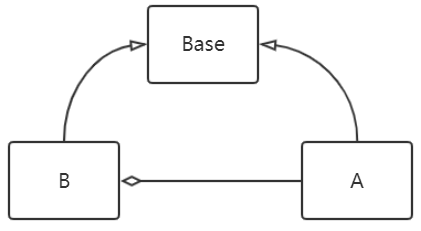
public class Liskov {
public static void main(String[] args) {
A a = new A();
System.out.println("11-3=" + a.func1(11, 3));
System.out.println("1-8=" + a.func1(1, 8));
System.out.println("-----------------------");
B b = new B();
System.out.println("11+3=" + b.func1(11, 3));//这里本意是求出11-3
System.out.println("1+8=" + b.func1(1, 8));// 1-8
System.out.println("11-3+9=" + b.func2(11, 3));
}
}
class Base{
// 把更加基础得方法和成员写到Base类
}
class A extends Base{
public int func1(int a, int b){
return a - b;
}
}
class B extends Base{
private A obj = new A();
public int func1(int a, int b){
return a + b;
}
public int func2(int a, int b){
return obj.func1(a, b) + 9;
}
}
开闭原则
基本介绍
1、开闭原则(Open Closed Principle)是编程中最基础、最重要的设计原则;
2、一个软件实体如类,模块和函数应该对扩展开放(对提供方),对修改关闭(对使用方)。用抽象构建框架,用实现扩展细节;
3、当软件需要变化时,尽量通过扩展软件实体的行为来实现变化,而不是通过修改已有的代码来实现变化;
4、编程中遵循其它原则,以及使用设计模式的目的就是遵循开闭原则。
下面我们以具体得实例分析。
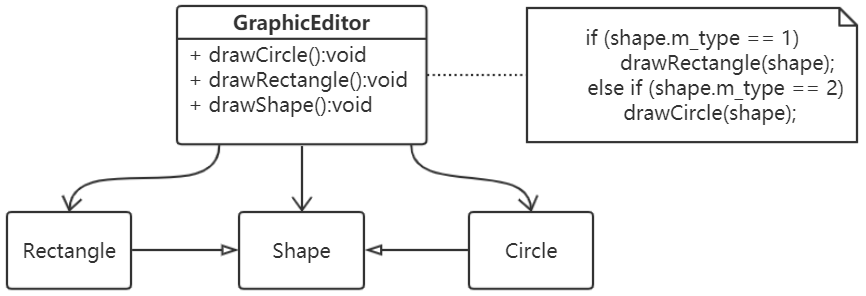
public class OpenClose {
public static void main(String[] args) {
GraphicEditor graphicEdirot = new GraphicEditor();
graphicEdirot.drawShape(new Rectangle());
graphicEdirot.drawShape(new Rectangle());
}
}
class Shape{
int m_type;
}
class Rectangle extends Shape{
public Rectangle() {
super.m_type = 1;
}
}
class Circle extends Shape{
public Circle(){
super.m_type = 2;
}
}
class GraphicEditor {
public void drawShape(Shape shape){
if (shape.m_type == 1)
drawRectangle(shape);
else if (shape.m_type == 2)
drawCircle(shape);
}
public void drawRectangle(Shape shape){
System.out.println("矩形");
}
public void drawCircle(Shape shape){
System.out.println("圆形");
}
}
上述实现方法得优点是比较好理解,简单易操作。但是,缺点是违反了设计模式的ocp原则,即对扩展开放(提供方),对修改关闭(使用方)。即当我们给类增加新功能的时候,尽量不修改代码,或者尽可能少修改代码.
比如我们这时要新增加一个图形种类三角形,我们需要做如下修改,修改的地方较多。
// 1.新增三角形
class Triangle extends Shape{
public Triangle() {
super.m_type = 3;
}
}
// 2.修改图形绘制类
class GraphicEditor {
public void drawShape(Shape shape){
if (shape.m_type == 1)
drawRectangle(shape);
else if (shape.m_type == 2)
drawCircle(shape);
else if(shape.m_type == 3)
drawTriangle(shape);
}
// 3.新增三角形绘制方法
public void drawTriangle(Shape shape){
System.out.println("三角形");
}
}
针对上述问题的解决思路:把创建Shape类做成抽象类,并提供一个抽象的draw方法,让子类去实现即可,这样我们有新的图形种类时,只需要让新的图形类继承Shape,并实现draw方法即可,使用方的代码就不需要修->满足了开闭原则。
public class OpenClose {
public static void main(String[] args) {
GraphicEditor graphicEditor = new GraphicEditor();
graphicEditor.drawShape(new Rectangle());
graphicEditor.drawShape(new Rectangle());
}
}
abstract class Shape{
public abstract void draw();
}
class Rectangle extends Shape {
@Override
public void draw() {
System.out.println("矩形");
}
}
class Circle extends Shape {
@Override
public void draw() {
System.out.println("圆形");
}
}
class Triangle extends Shape {
@Override
public void draw() {
System.out.println("三角形");
}
}
class GraphicEditor {
public void drawShape(Shape shape){
shape.draw();
}
}
迪米特法则
基本介绍
1、一个对象应该对其他对象保持最少的了解;
2、类与类关系越密切,耦合度越大;
3、迪米特法则(DemeterPrinciple)又叫最少知道原则,即一个类对自己依赖的类知道的越少越好。也就是说,对于被依赖的类不管多么复杂,都尽量将逻辑封装在类的内部。对外除了提供的public方法,不对外泄露任何信息;
4、迪米特法则还有个更简单的定义:只与直接的朋友通信;
5、直接的朋友:每个对象都会与其他对象有耦合关系,只要两个对象之间有耦合关系,我们就说这两个对象之间是朋友关系。耦合的方式很多,依赖,关联,组合,聚合等。其中,我们称出现成员变量,方法参数,方法返回值中的类为直接的朋友,而出现在局部变量中的类不是直接的朋友。也就是说,陌生的类最好不要以局部变量的形式出现在类的内部。
现在我们看一下具体的案例:有一个学校,下属有各个学院和总部,现要求打印出学校总部员工ID和学院员工的id。
import java.util.ArrayList;
import java.util.List;
public class Demeter {
public static void main(String[] args) {
//创建了一个 SchoolManager 对象
SchoolManager schoolManager = new SchoolManager();
//输出学院的员工id 和 学校总部的员工信息
schoolManager.printAllEmployee(new CollegeManager());
}
}
//学校总部员工类
class Employee {
private String id;
public void setId(String id) {
this.id = id;
}
public String getId() {
return id;
}
}
//学院的员工类
class CollegeEmployee {
private String id;
public void setId(String id) {
this.id = id;
}
public String getId() {
return id;
}
}
//管理学院员工的管理类
class CollegeManager {
//返回学院的所有员工
public List<CollegeEmployee> getAllEmployee() {
List<CollegeEmployee> list = new ArrayList<CollegeEmployee>();
for (int i = 0; i < 10; i++) { //这里我们增加了10个员工到 list
CollegeEmployee emp = new CollegeEmployee();
emp.setId("学院员工id= " + i);
list.add(emp);
}
return list;
}
}
//学校管理类
//分析 SchoolManager 类的直接朋友类有哪些 Employee、CollegeManager
//CollegeEmployee 不是 直接朋友 而是一个陌生类,这样违背了 迪米特法则
class SchoolManager {
//返回学校总部的员工
public List<Employee> getAllEmployee() {
List<Employee> list = new ArrayList<Employee>();
for (int i = 0; i < 5; i++) { //这里我们增加了5个员工到 list
Employee emp = new Employee();
emp.setId("学校总部员工id= " + i);
list.add(emp);
}
return list;
}
//该方法完成输出学校总部和学院员工信息(id)
void printAllEmployee(CollegeManager sub) {
//分析问题
//1. 这里的 CollegeEmployee 不是 SchoolManager的直接朋友
//2. CollegeEmployee 是以局部变量方式出现在 SchoolManager
//3. 违反了 迪米特法则
//获取到学院员工
List<CollegeEmployee> list1 = sub.getAllEmployee();
System.out.println("------------学院员工------------");
for (CollegeEmployee e : list1) {
System.out.println(e.getId());
}
//获取到学校总部员工
List<Employee> list2 = this.getAllEmployee();
System.out.println("------------学校总部员工------------");
for (Employee e : list2) {
System.out.println(e.getId());
}
}
}
前面设计的问题在于SchoolManager中,CollegeEmployee类并不是
SchoolManager类的直接朋友(分析)。按照迪米特法则,应该避免类中出现这样非直接朋友关系的耦合,下面对代码按照迪米特法则进行改进。
//1、管理学院员工的管理类
class CollegeManager {
//返回学院的所有员工
public List<CollegeEmployee> getAllEmployee() {
List<CollegeEmployee> list = new ArrayList<CollegeEmployee>();
for (int i = 0; i < 10; i++) { //这里我们增加了10个员工到 list
CollegeEmployee emp = new CollegeEmployee();
emp.setId("学院员工id= " + i);
list.add(emp);
}
return list;
}
//输出学院员工的信息
public void printEmployee() {
//获取到学院员工
List<CollegeEmployee> list1 = getAllEmployee();
System.out.println("------------学院员工------------");
for (CollegeEmployee e : list1) {
System.out.println(e.getId());
}
}
}
// 2、修改SchoolManager
class SchoolManager {
//返回学校总部的员工
public List<Employee> getAllEmployee() {
List<Employee> list = new ArrayList<Employee>();
for (int i = 0; i < 5; i++) { //这里我们增加了5个员工到 list
Employee emp = new Employee();
emp.setId("学校总部员工id= " + i);
list.add(emp);
}
return list;
}
//该方法完成输出学校总部和学院员工信息(id)
void printAllEmployee(CollegeManager sub) {
//分析问题
//1. 将输出学院的员工方法,封装到CollegeManager
sub.printEmployee();
//获取到学校总部员工
List<Employee> list2 = this.getAllEmployee();
System.out.println("------------学校总部员工------------");
for (Employee e : list2) {
System.out.println(e.getId());
}
}
}
迪米特法则的核心是降低类之间的耦合,但是注意:由于每个类都减少了不必要的依赖,因此迪米特法则只是要求降低类间(对象间)耦合关系,并不是要求完全没有依赖关系。
合成复用原则
基本介绍: 原则是尽量使用合成/聚合的方式,而不是使用继承。
(1)继承
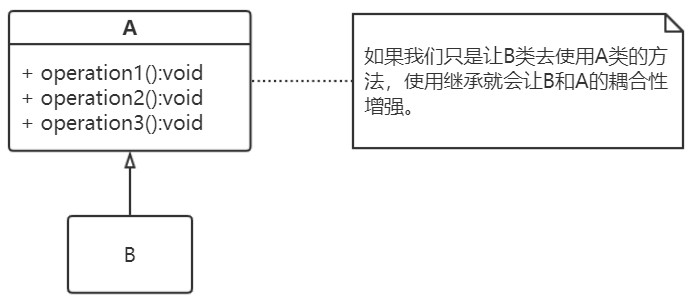
(2)依赖

(3)聚合

(4)组合

设计原则核心思想是:
1、找出应用中可能需要变化之处,把它们独立出来,不要和那些不需要变化的代码混在一起;
2、针对接口编程,而不是针对实现编程;
3、为了交互对象之间的松耦合设计而努力。

